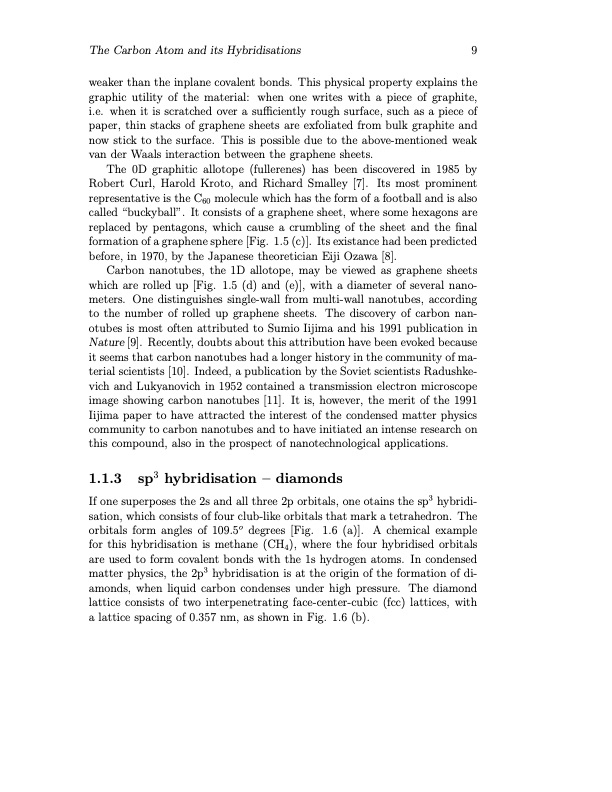PDF Publication Title:
Text from PDF Page: 013
The Carbon Atom and its Hybridisations 9 weaker than the inplane covalent bonds. This physical property explains the graphic utility of the material: when one writes with a piece of graphite, i.e. when it is scratched over a sufficiently rough surface, such as a piece of paper, thin stacks of graphene sheets are exfoliated from bulk graphite and now stick to the surface. This is possible due to the above-mentioned weak van der Waals interaction between the graphene sheets. The 0D graphitic allotope (fullerenes) has been discovered in 1985 by Robert Curl, Harold Kroto, and Richard Smalley [7]. Its most prominent representative is the C60 molecule which has the form of a football and is also called “buckyball”. It consists of a graphene sheet, where some hexagons are replaced by pentagons, which cause a crumbling of the sheet and the final formation of a graphene sphere [Fig. 1.5 (c)]. Its existance had been predicted before, in 1970, by the Japanese theoretician Eiji Ozawa [8]. Carbon nanotubes, the 1D allotope, may be viewed as graphene sheets which are rolled up [Fig. 1.5 (d) and (e)], with a diameter of several nano- meters. One distinguishes single-wall from multi-wall nanotubes, according to the number of rolled up graphene sheets. The discovery of carbon nan- otubes is most often attributed to Sumio Iijima and his 1991 publication in Nature [9]. Recently, doubts about this attribution have been evoked because it seems that carbon nanotubes had a longer history in the community of ma- terial scientists [10]. Indeed, a publication by the Soviet scientists Radushke- vich and Lukyanovich in 1952 contained a transmission electron microscope image showing carbon nanotubes [11]. It is, however, the merit of the 1991 Iijima paper to have attracted the interest of the condensed matter physics community to carbon nanotubes and to have initiated an intense research on this compound, also in the prospect of nanotechnological applications. 1.1.3 sp3 hybridisation – diamonds If one superposes the 2s and all three 2p orbitals, one otains the sp3 hybridi- sation, which consists of four club-like orbitals that mark a tetrahedron. The orbitals form angles of 109.5o degrees [Fig. 1.6 (a)]. A chemical example for this hybridisation is methane (CH4), where the four hybridised orbitals are used to form covalent bonds with the 1s hydrogen atoms. In condensed matter physics, the 2p3 hybridisation is at the origin of the formation of di- amonds, when liquid carbon condenses under high pressure. The diamond lattice consists of two interpenetrating face-center-cubic (fcc) lattices, with a lattice spacing of 0.357 nm, as shown in Fig. 1.6 (b).PDF Image | Physical Properties of Graphene

PDF Search Title:
Physical Properties of GrapheneOriginal File Name Searched:
CoursGraphene2008.pdfDIY PDF Search: Google It | Yahoo | Bing
Salgenx Redox Flow Battery Technology: Power up your energy storage game with Salgenx Salt Water Battery. With its advanced technology, the flow battery provides reliable, scalable, and sustainable energy storage for utility-scale projects. Upgrade to a Salgenx flow battery today and take control of your energy future.
CONTACT TEL: 608-238-6001 Email: greg@infinityturbine.com (Standard Web Page)